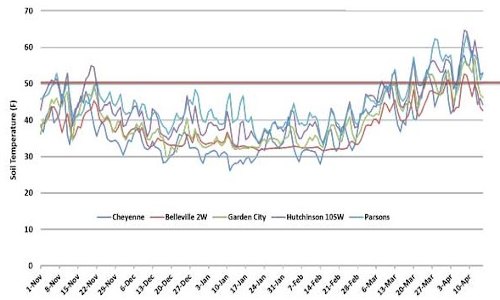When field conditions allow, fall application of nitrogen (N) is a common practice for Kansas producers. Once spring arrives, a question arises about the level of residual profile N in soil due to the potential for N loss since application. Knowing if the N loss potential was high is important when deciding on the appropriate nitrogen management plan for the growing season.
Potential for N loss from fall-applied N
Nitrogen loss processes are associated with the nitrate-N (NO3-) form of nitrogen. Nitrification is the conversion from ammonium (NH4+) to nitrate. Nitrification is a biological process (involves soil bacteria) and is driven by soil oxygen content, soil temperature, pH, how the N was applied, and some characteristics of the fertilizer. Nitrification is an aerobic process, thus requiring high levels of soil oxygen. Conditions that reduce oxygen supplies, such as wet soils, will inhibit nitrification and keep N in the ammonium form.
Nitrification is also a temperature-driven process. Fall applications of ammonia-based fertilizers are most effective when soil temperatures remain below 50oF, inhibiting nitrification. The cold soils in recent months minimized any microbial activity and the conversion of ammonium to the nitrate-N form (Figure 1). Thus, up to this point, the ammonium-based N fertilizers applied last fall will not be subject to loss given the recent conditions of cold soils across the state. Fertilizer applied as ammonia or urea, and the 75% of UAN that is in ammonium/ammonium-producing forms, will remain in the soil in the ammonium form until soils warm up and dry out later in the spring.

Figure 1. Average 4-inch soil temperatures from November 1, 2019 to April 15, 2020 for five locations across Kansas. Source: Kansas Mesonet.
Residual profile N
The amount of nitrogen in the profile can be hard to predict. The good news is that it is not too late to collect 24-inch profile soil samples to determine how much N is available for the upcoming crop. Due to the wet fall and winter on the eastern side of that state again this year (Figure 2), it is possible that some of last year’s N was lost due to leaching and denitrification. However, the potential exists for a significant amount to still be retained in the soil profile. Taking profile N samples this spring will allow producers to account for and take advantage of unutilized N and could represent a savings on N inputs this year. For more information on collecting and submitting profile N soil samples, please see KSRE publication MF734, “Soil Testing Laboratory”.

Figure 2. Fall and winter precipitation (November 1, 2019 to April 15, 2020). Map by K-State Weather Data Library.
Source : ksu.edu